|
|
|
Sort Order |
|
|
|
Items / Page
|
|
|
|
|
|
|
| Srl | Item |
| 1 |
ID:
169123
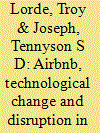

|
|
|
|
|
| Summary/Abstract |
This paper focuses on how Airbnb, an internet platform which has created the possibility for mass participation in the tourism market, is resulting in class conflict between new entrants and the ‘traditional’ tourism industry. Specifically, it studies how traditional tourism interests in Barbados have responded to Airbnb by seeking to restrict participation in the industry and presents this as a microcosm of broader class transitions and conflicts associated with new technologies. The paper utilises a Marxist theoretical perspective buttressed by Joseph Schumpeter’s theory of ‘creative destruction’ – places emphasis on the process of destroying productive systems to understand how specific industries expand and survive – and Clayton Christensen’s notion of ‘disruptive innovation’ – a process by which a disruptive product transforms a market – for studying how transformations in technology are impacting the tourism industry in Barbados. Its aim is to provide an account of how the process of disruption is unfolding in Barbados by highlighting the reactions of the main hotel lobby group to Airbnb, while also applying the ideas of Marx, Schumpeter and Christensen as useful theoretical lenses through which to examine the unfolding of the process of disruption of settled class and historical control of a dominant economic sector by new technologies.
|
|
|
|
|
|
|
|
|
|
|
|
|
|
|
|
| 2 |
ID:
105337
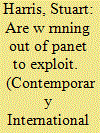

|
|
|
|
|
| Publication |
2011.
|
| Summary/Abstract |
Many people have begun to concern about the potential resources shortages against the backdrop of rapid economic growth. Paul Krugman wrote an article titled 'Running out of Planet to exploit', and in this article, the author will address the Krugman question, and to consider whether the key factor is the decision-making capacity of the international community in dealing with and adapting to the substantial interactions between energy, land, water, and food supply, and the potential global resource scarcities in these four areas-the links and limits in the paper's title.
|
|
|
|
|
|
|
|
|
|
|
|
|
|
|
|
| 3 |
ID:
128638


|
|
|
|
|
| Publication |
2013.
|
| Summary/Abstract |
The author, in a three part series examines the evolution of naval warfighting doctrine, with examples, and seeks to set out a grammar of doctrine.
Within the context of the present highly complex and shifting environment and in the face rapid technological change, it is not unreasonable to question the validity of doctrine - Albert Palazzo -2008
Knowing the enemy is the bedrock of the business of strategy: strategic theories in comparison, are second order problems. To concentrate on doctrine before enemies is to put the theoretical cart before the actual horse -a double error - Ken Booth, 1979
Doctrine is the box outside of which we need to think- Colonel Rory Copinger, Symes, Royal Marine-2010
|
|
|
|
|
|
|
|
|
|
|
|
|
|
|
|
| 4 |
ID:
128659


|
|
|
|
|
| Publication |
2013.
|
| Summary/Abstract |
In the second part of his series of articles, the author examines the development of naval doctrine through the 18th century, culminating in the production and publication of the fighting doctrine which informed the first world war, and governed the conduct of the battle of Jutland in 1916
|
|
|
|
|
|
|
|
|
|
|
|
|
|
|
|
| 5 |
ID:
128720


|
|
|
|
|
| Publication |
2013.
|
| Summary/Abstract |
In this the concluding part of his series on the chemistry of doctrine, the author examines the further evolution of naval doctrine during the second world war, with specific reference to the battle of Atlantic . He concludes by surveying the whole three part series and drawing some enduring lessons and principles.
|
|
|
|
|
|
|
|
|
|
|
|
|
|
|
|
| 6 |
ID:
124478


|
|
|
|
|
| Publication |
2013.
|
| Summary/Abstract |
Social, political, and technological changes have forced changes in the contemporary Moroccan linguistic landscape. In print media, advertising, music, fictional writing, and translation, Moroccan Arabic (d?rija) is being written in a variety of ways that point to a shift in perceptions and usage of d?rija in daily Moroccan life. In this article, I provide a discussion of recent developments in the use of d?rija in writing, and discuss how this evolving situation is articulated by intellectuals, journalists, publishers, fiction writers, and translators.
|
|
|
|
|
|
|
|
|
|
|
|
|
|
|
|
| 7 |
ID:
112274


|
|
|
|
|
| Publication |
2012.
|
| Summary/Abstract |
In the power sector, technological change is a key lever to address the decarbonisation needed to avoid dangerous climate change. Policy makers aim to accelerate and redirect technological change by targeting relevant firms via climate policy, e.g., the European Union Emissions Trading System (EU ETS), and climate-relevant technology policies, e.g., feed-in tariffs. Changes in firm's behaviour, i.e., their research and development (R&D) as well as diffusion activities, are at the heart of technological change. However, firms are heterogeneous actors with varying attributes which perceive policy differently. Hence, they can be expected to react very heterogeneously to these new policies. Based on an original dataset of 201 firms, we perform a cluster analysis grouping firms along their R&D and diffusion activity changes. We then compare these clusters with regards to the characteristics of the contained firms. Our analysis results in seven clusters showing very diverse contributions to low-carbon technological change, suggesting potential for policy to become more effective. A comparison of the firms' characteristics allows us to derive indicative recommendations on how to adjust the policy mix in order to induce contributions from most firms in the power sector.
|
|
|
|
|
|
|
|
|
|
|
|
|
|
|
|
| 8 |
ID:
149913


|
|
|
|
|
| Summary/Abstract |
National-level policies to promote deployment of low-carbon technologies have been suggested and used as a means to reduce greenhouse gas emissions in the context of international climate change mitigation. The long-term benefits of such policies in the context of international climate change mitigation depend on their effects on near-term emissions abatement and resultant long-term technological change that will reduce abatement costs of achieving global mitigation goals. There is also an argument that these policies might foster early-mover advantages in international low-carbon technology markets. We first review the factors that could influence such benefits and use a global integrated assessment model to present an illustrative example to understand the potential magnitude of these benefits. We find that reductions in long-term abatement costs might not provide sufficient incentives to justify policies to promote the deployment of low-carbon technologies, in particular, the emerging, higher-risk, and currently expensive alternatives. We also find that early-mover advantages can potentially provide substantial benefits, but only if these advantages are both strong and persistent. Our results suggest a role for international cooperation in low-carbon technology deployment to address the existence of free-riding opportunities in the context of global climate change mitigation.
|
|
|
|
|
|
|
|
|
|
|
|
|
|
|
|
| 9 |
ID:
087365
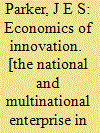

|
|
|
|
|
| Publication |
London, Longman, 1974.
|
| Description |
viii, 297p.
|
| Standard Number |
0582446090
|
|
|
|
|
|
|
|
|
|
|
|
Copies: C:1/I:0,R:0,Q:0
Circulation
| Accession# | Call# | Current Location | Status | Policy | Location |
| 015028 | 338.88/PAR 015028 | Main | On Shelf | General | |
|
|
|
|
| 10 |
ID:
052638


|
|
|
| 11 |
ID:
133312


|
|
|
|
|
| Publication |
2014.
|
| Summary/Abstract |
We evaluate the contribution of technological change in reducing CO2 emissions in the Italian pulp and paper industry during the first and second phases of application of the European Union Emission Trading System (EU-ETS). We decompose the variation in emission and emission intensity into three different types of effects: a composition effect, a technique effect and a scale effect. The composition effect measures the change in emissions and emissions intensity due to a shift in production towards products that cause less emissions. The technique effect measures the change per each type of product, thereby accounting for technology improvements in the production of each type of good produced. The scale effect singles out the reduction in total emission due to an overall reduction in output. We show that the first phase of the application of EU-ETS has led to a reduction in both emissions and emission intensity due to the composition effect. The technological change has had a limited negative impact on emissions in the first phase, while in the second phase there has been limited technology improvement in the industry. However, the figures of the scale effect show that the larger reduction in emission is due to the overall decrease in output.
|
|
|
|
|
|
|
|
|
|
|
|
|
|
|
|
| 12 |
ID:
162346
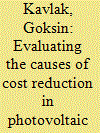

|
|
|
|
|
| Summary/Abstract |
Photovoltaic (PV) module costs have declined rapidly over forty years but the reasons remain elusive. Here we advance a conceptual framework and quantitative method for quantifying the causes of cost changes in a technology, and apply it to PV modules. Our method begins with a cost model that breaks down cost into variables that changed over time. Cost change equations are then derived to quantify each variable's contribution. We distinguish between changes observed in variables of the cost model – which we term low-level mechanisms of cost reduction – and research and development, learning-by-doing, and scale economies, which we refer to as high-level mechanisms. We find that increased module efficiency was the leading low-level cause of cost reduction in 1980–2012, contributing almost 25% of the decline. Government-funded and private R&D was the most important high-level mechanism over this period. After 2001, however, scale economies became a more significant cause of cost reduction, approaching R&D in importance. Policies that stimulate market growth have played a key role in enabling PV's cost reduction, through privately-funded R&D and scale economies, and to a lesser extent learning-by-doing. The method presented here can be adapted to retrospectively or prospectively study many technologies, and performance metrics besides cost.
|
|
|
|
|
|
|
|
|
|
|
|
|
|
|
|
| 13 |
ID:
125181


|
|
|
|
|
| Publication |
2013.
|
| Summary/Abstract |
The introduction of the long-playing record in 1948 was the most aesthetically significant technological change in the century of the recorded music disc. The new format challenged record producers and recording artists of the 1950s to group sets of songs into marketable wholes and led to a first generation of concept albums that predate more celebrated examples by rock bands from the 1960s. Two strategies used to unify concept albums in the 1950s stand out. The first brought together performers unlikely to collaborate in the world of live music making. The second strategy featured well-known singers in songwriter-or performer-centered albums of songs from the 1920s, 1930s, and 1940s recorded in contemporary musical styles. Recording artists discussed include Fred Astaire, Ella Fitzgerald, and Rosemary Clooney, among others.
|
|
|
|
|
|
|
|
|
|
|
|
|
|
|
|
| 14 |
ID:
177095
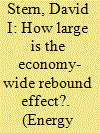

|
|
|
|
|
| Summary/Abstract |
The size of the economy-wide rebound effect is crucial for estimating the contribution that energy efficiency improvements can make to reducing greenhouse gas emissions and for understanding the drivers of energy use. Economy-wide rebound from an energy efficiency improvement includes changes in the use of energy to produce complementary and substitute goods or inputs and other flow-on effects that affect energy use across the economy as well as the direct rebound due to energy users using more of an energy service that has become less costly as result of improved energy efficiency. Jevons first argued in 1865 that improvements in energy efficiency increase total energy use, and in recent decades researchers have argued for and against this “backfire” hypothesis. Theory provides some guidance on the factors affecting rebound but does not impose much constraint on the range of possible responses. Historical evidence suggests that the improved energy efficiency of recent technology has not reduced energy use because consumption has shifted to more energy-intensive goods and services. Simulations and econometric research have produced mixed results. Some recent general equilibrium studies find large rebound, around 100%, but more research is needed to confirm or refute these findings.
|
|
|
|
|
|
|
|
|
|
|
|
|
|
|
|
| 15 |
ID:
117318


|
|
|
|
|
| Publication |
2013.
|
| Summary/Abstract |
Uncertainty about long-term climate policy is a major driving force in the evolution of the carbon market price. Since this price enters the investment decision process of regulated firms, this uncertainty increases the cost of capital for investors and might deter investments into new technologies at the company level. We apply a real options-based approach to assess the impact of climate change policy in the form of a constant or growing price floor on investment decisions of a single firm in a competitive environment. This firm has the opportunity to switch from a high-carbon "dirty" technology to a low-carbon "clean" technology. Using Monte Carlo simulation and dynamic programming techniques for real data, we determine the optimal CO2 price floor level and growth rate in order to induce investments into the low-carbon technology. We find that a carbon price floor can be used to induce earlier low-carbon technology investment and show this result to be robust to a large variety of input parameter settings.
|
|
|
|
|
|
|
|
|
|
|
|
|
|
|
|
| 16 |
ID:
150477


|
|
|
|
|
| Summary/Abstract |
Given the interest in the commercialization of affordable, clean energy technologies, we examine the prospects of solar photovoltaics (PV). We consider the question of how to transition to a meaningful percentage of solar energy in a sustainable manner and which policies are most effective in accelerating adoption. This paper develops a stochastic dynamic model of the adoption of solar PV in the residential and commercial sector under two sources of uncertainty – the price of electricity and cost of solar. The analytic results suggest that a high rate of innovation may delay adoption of a new technology if the consumer has rational price expectations. We simulate the model across alternative rates technological change, electricity prices, subsidies and carbon taxes. It is shown that there will be a displacement of incumbent technologies and a widespread shift towards solar PV in under 30 years – and that this can occur without consumer incentives and carbon pricing. We show that these policies have a modest impact in accelerating adoption, and that they may not be an effective part of climate policy. Instead, results demonstrate that further technological change is the crucial determinant and main driver of adoption. Further, results indicate that subsidies and taxes become increasingly ineffective with higher rates of technological change.
|
|
|
|
|
|
|
|
|
|
|
|
|
|
|
|
| 17 |
ID:
107313
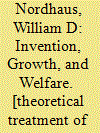

|
|
|
|
|
| Publication |
Massachusetts, M.I.T.Press, 1969.
|
| Description |
xiv, 168p.Hbk
|
| Series |
M.I.T. Monographs in Economics
|
|
|
|
|
|
|
|
|
|
|
|
Copies: C:1/I:0,R:0,Q:0
Circulation
| Accession# | Call# | Current Location | Status | Policy | Location |
| 004130 | 608/NOR 004130 | Main | On Shelf | General | |
|
|
|
|
| 18 |
ID:
099344
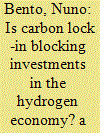

|
|
|
|
|
| Publication |
2010.
|
| Summary/Abstract |
The difficulty of introducing hydrogen and fuel cells in the market stems from the fact that they are not an evolutionary innovation such as biofuels or hybrid cars. Instead they create a disruption in technological utilization. The domination of oil technologies sets a socio-economical context favoring actors involved in the current paradigm, and gives less opportunity to alternative fuels to develop and challenge the status quo. If this hypothesis is correct, then companies interested in the hydrogen economy would not become active because of an unstable context or contradictory interests concerning the replacement of the present system. A review of actions and announcements of main actors shows that technology readiness and the absence of infrastructure are the major justifications to delay investments. Some measures are discussed, which could be deployed in order to reduce uncertainties, such as regulation of carbon emissions from cars, technological subvention, and partnerships for infrastructure implementation.
|
|
|
|
|
|
|
|
|
|
|
|
|
|
|
|
| 19 |
ID:
132179


|
|
|
|
|
| Publication |
2014.
|
| Summary/Abstract |
The present squeeze on military funding is not the first such measure, nor will it likely be the last. The country had little trust in a standing army, and the support provided in time.
|
|
|
|
|
|
|
|
|
|
|
|
|
|
|
|
| 20 |
ID:
137703
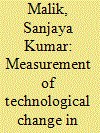

|
|
|
|
|
| Summary/Abstract |
This article measures technological change in India’s textile machinery industry, and examines how user–producer interaction affects this. Employing the non-parametric Malmquist productivity index, we find there has been little technological change in the textile machinery industry from 1998–99 through 2007–08. It is proposed that poor and unsustainable demand and the shrinking share of domestic demand for textile machinery owing to the technological upgradation fund scheme—meant for providing interest reimbursements or capital subsidies to textile manufacturers—may have weakened the user–producer interactions, thereby bringing down innovative activities and innovations in the textile machinery industry in India.
JEL Classification: O14, O33, C14
|
|
|
|
|
|
|
|
|
|
|
|
|
|
|
|
|
|
|
|
|